Red foxes can flip between friendly and unfriendly based on their experiences and surroundings. In urban areas, some become more curious and bold, often seeking food from humans. This doesn't mean they want to be your best friend, though! Their behavior can also vary based on genetics and social dynamics. Some might be playful and social, while others remain shy and cautious. It's vital to respect their wildness, even if they seem friendly. So, if you're curious about how to interact with these clever creatures thoughtfully, there's plenty more to discover about their behavior and habits!
Contents
Urban Fox Behavior
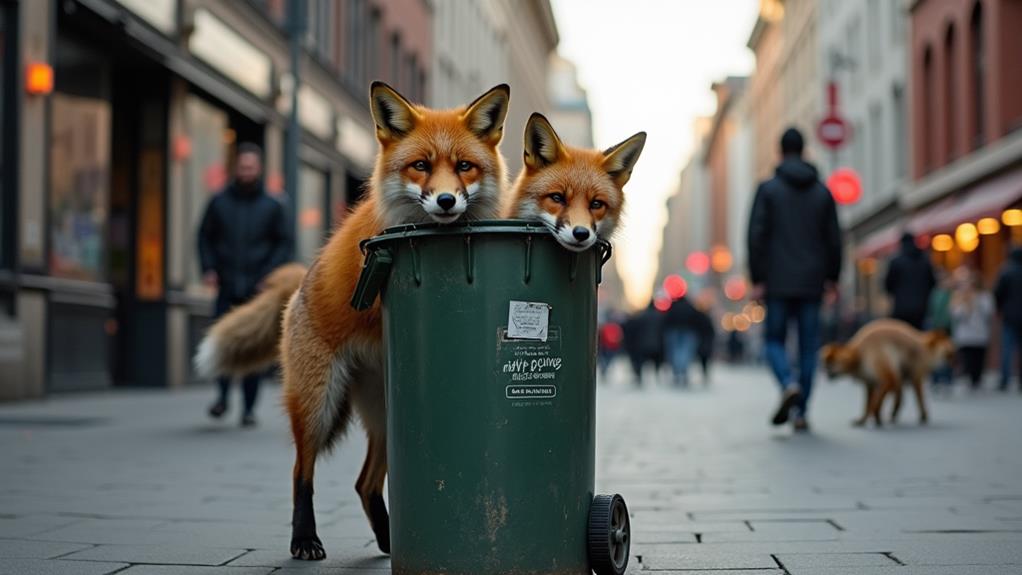
In urban settings, you'll notice that red foxes have adapted remarkably to human presence. Since the late 1930s, these clever critters have become more daring, often surprising you with their boldness.
They've learned to blend into your neighborhoods, thanks to fewer threats and a buffet of food options! Their ability to thrive is partly due to effective foraging techniques in parks and gardens, allowing them to access a variety of food sources, including urban habitats that contribute to their survival.
When you observe urban foxes, you'll see a mix of personalities. Some are shy, darting away at the first sign of movement, while others may hang around a bit longer, sizing you up.
Their playful antics, like cubs frolicking about, can be a joy to witness, even engaging with children as if they're just part of the neighborhood.
One thing to remember is that these fox populations often thrive because they find easy meals in gardens. If you're feeding them, you might end up with a regular visitor!
But don't worry—urban foxes generally approach humans for food and not out of aggression. Still, it's important to maintain a respectful distance. After all, while they seem nifty, they're wild animals at heart, deserving their space!
Factors Influencing Boldness
Understanding what makes red foxes bold can be intriguing, especially as you observe their behavior in urban environments. You might notice how some foxes confidently approach unfamiliar objects, while others act a bit more skittish. This boldness often stems from individual experiences and the environment they find themselves in.
In bustling urban areas, where food and excitement abound, foxes tend to be more daring, shedding their natural wariness towards humans. These foxes demonstrate impressive adaptability, as evidenced by their thriving population in urban UK, where they navigate human-dominated spaces and scavenge for food, a behavior linked to their dietary habits that include household refuse and small pets their habits and habitats.
It's fascinating how the shy-bold continuum illustrates that not all foxes are created equal. Dominant individuals might be more cautious, while those lower in the social hierarchy often display bolder behavior. And don't forget the genetic factors at play! Some foxes inherit traits that make them more aggressive or friendlier, shaping their personalities.
Social dynamics within their family groups also play an essential role. Experiencing life together, these foxes learn from one another, creating a spectrum of boldness.
Feeding and Human Interaction
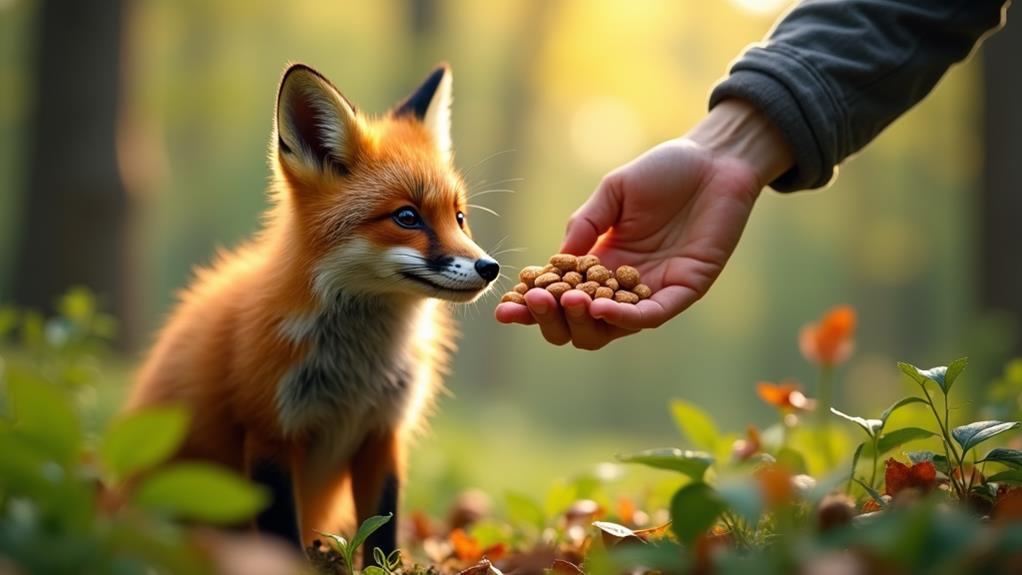
Feeding red foxes can be a delightful way to connect with these clever creatures, as urban foxes have shown remarkable adaptability to human environments, demonstrating behaviors like scavenging and foraging within cities urban foxes thrive.
However, it's important to do it right. By gradually building trust through regular, responsible feeding, you can create a bond without setting them up for dependency.
Just remember, while sharing your snacks might feel warm and fuzzy, it can lead to some tricky situations if they start viewing you as their personal food vendor!
Proper Feeding Techniques
While it's tempting to approach red foxes with treats in hand, responsible feeding techniques are essential for their well-being and your safety. You might think that sharing a snack would win their hearts, but moderation is key!
If you decide to feed foxes, scatter their food in different spots. This prevents territorial disputes among multiple visitors—nobody wants a fox showdown in their yard.
Stick to fresh, natural foods that resemble their usual prey, and steer clear of processed goodies like chocolate. Trust us, those are a big no-no! Not only will proper feeding techniques keep foxes healthy, but they'll also maintain their wild independence, which is super important.
Don't forget to provide fresh water! Just like us, foxes need hydration to thrive.
Instead of hand feeding, it's better to observe from a distance. This way, you'll avoid creating dependent foxes, fostering a respectful relationship.
Building Trust Gradually
Building trust with red foxes takes patience and consistency. When you start feeding foxes regularly, you help them associate you with food, which is a big deal!
Gradual feeding is like a friendship starter pack for foxes and people. They might even learn to ignore your presence when they see you as a reliable food source. Isn't that amazing?
To keep your furry friends healthy, it's important to use responsible feeding practices. Avoid processed foods; they can mess with a fox's system. Instead, scatter the food to promote a peaceful dining experience—no need for territorial disputes here!
Believe it or not, individual foxes can recognize the specific humans who feed them. They might trust you but will likely be cautious around new faces (sorry, stranger!).
Don't forget water! Providing a drink along with meals not only aids their health but can really help build that trust over time.
You'll be surprised at how this nurturing approach creates a special bond between you and local foxes, turning you into their trusted friend. Just remember, every little act of kindness counts!
Risks of Dependency
Creating a bond with red foxes through feeding can sometimes lead to unintended consequences. You might think you're helping these clever creatures, but feeding them regularly can create a dangerous dependency. When red foxes get used to human food, they may lose their natural foraging skills and, even worse, start approaching people for snacks.
Sure, that may seem adorable at first, but it can also lead to bold behavior that increases the risk of conflict. You should remember that while foxes adapt well, consistently feeding them can dull their wariness of humans. Nobody wants a bold fox scrounging at their picnic!
Thankfully, you can practice responsible feeding. Scattering food and providing water helps keep their instincts sharp while still offering a little support. Just know that while a fox may seem friendly when you feed it, that trust isn't guaranteed forever.
Every fox's experience is unique, shaped by individual encounters and their surroundings.
Risks to Pets and Livestock
Red foxes can pose a risk to small pets and livestock, particularly in suburban and rural areas where human encroachment overlaps with their natural habitat.
While foxes are intelligent creatures, they sometimes see small pets like kittens and tiny dogs as easy targets if they look vulnerable or if food is running low. Adult cats often manage to stay safe, but leaving kittens unsupervised outside can spell trouble.
You'd be surprised, but these clever critters typically avoid confrontation with dogs.
Still, if a larger dog gets too close to a fox's den, the fox might feel cornered and react defensively. So, ensuring your pets are safe is key!
To keep your furry friends from becoming unwitting snacks, consider securing their play areas.
Fencing and enclosed spaces can help minimize risks to pets and livestock and give you peace of mind.
Remember, foxes prefer to live their lives out in the wild, just like we do.
Genetic Influences on Behavior
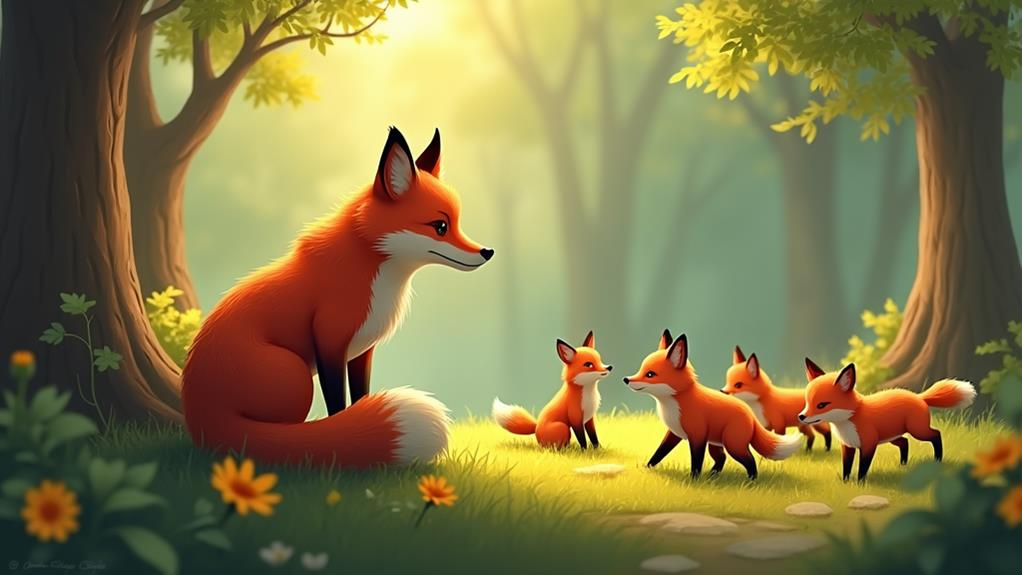
You might be surprised to learn just how much genetics shapes a red fox's behavior, including their levels of aggression and even their comfort around humans.
Think of it like this: some foxes are born with a natural boldness, while others might be a bit more shy, and these traits can affect how they interact with both other foxes and people.
As they adapt to different environments, like urban areas, their genetic makeup can lead to some interesting social dynamics—after all, not every fox is strutting around like they're the king of the block!
Genetic Traits and Aggression
Genetic traits greatly influence the behavior of red foxes, particularly regarding aggression and social tendencies. You might be surprised to learn that specific genes can dictate how aggressive or sociable a fox can be. Some foxes are born to be the life of the party, while others prefer to hang back and observe. Isn't that fascinating?
Studies, including cross-fostering research, reveal that upbringing matters, but it doesn't change those core genetic traits. If a fox is genetically inclined to be a bit nippy, it doesn't matter who it grows up with—it's likely to keep that spunky attitude. Think of this like a shy person who, no matter how friendly you are, still prefers to sit on the sidelines.
Additionally, the shy-bold continuum framework shows us how different genes allow foxes to adapt in unique ways. This variation adds richness to their behavior, affecting how they interact not just with each other, but also with humans.
Environmental Adaptation Strategies
Many factors influence how red foxes adapt to their environments, and their genetic makeup is a crucial piece of the puzzle. When you think about it, it's fascinating how some fox species thrive in urban areas while others remain cautious. This adaptability can be boiled down to a few key elements:
- Genetic Traits: Certain genes are linked to behaviors like aggression and sociability, shaping how these foxes react to humans.
- Individual Differences: Every fox has its quirks! Some are bold and adventurous, while others are shy and more reserved.
- Learning Experiences: A fox's interactions with humans can refine its behavior, allowing it to become more comfortable—or not—based on past encounters.
Even with all the influence of their surroundings, research shows that innate traits like tameness or aggression aren't easily changed by upbringing. It's like trying to teach a cat to fetch; some just aren't into that!
Understanding these genetic influences helps us appreciate why some red foxes might approach you in the park while others play hard to get. Isn't nature intriguing?
Social Learning Effects
Understanding the interplay between social learning and genetics reveals much about red fox behavior. Think of fox cubs learning from their wild foxes parents and the environment around them.
It turns out that while genetics shape traits like boldness or shyness, social experiences matter too. For instance, foxes can become friendly with humans who feed them, but that doesn't make them trust just anyone—it's a bit like how you can warm up to a neighbor but still be wary of strangers.
Research shows shy foxes might thrive better in changing environments, which contrasts with bold foxes who prefer predictability. It's captivating to see how this shy-bold continuum works among different foxes, highlighting the spectrum of personalities in this clever species.
Notably, cross-fostering studies reveal that upbringing doesn't greatly alter innate traits like aggression.
Misconceptions About Foxes
Foxes often get a bad rap, leading to misconceptions that can unfairly tarnish their reputation. You might hear things that make them sound much more menacing than they really are, especially in urban areas.
Let's clear up a few common myths:
- Dangerous Creatures: Many believe urban foxes are aggressive, but they're usually more interested in avoiding you than causing harm.
- Pests to Pets: It's a common fear that foxes will snatch your small pets, but interactions typically happen only if they feel threatened or cornered.
- Feeding Dependency: People worry that feeding foxes will make them dependent, but wildlife experts say foxes raised around humans can live independently after release.
It's easy to let misconceptions about foxes cloud your understanding.
These clever creatures are often misunderstood due to exaggerated fears and misunderstandings about their behavior.
The next time you see a fox in your neighborhood, remember: they're just trying to navigate life among us, not plotting to invade your backyard barbecue.
Wildlife Engagement Best Practices
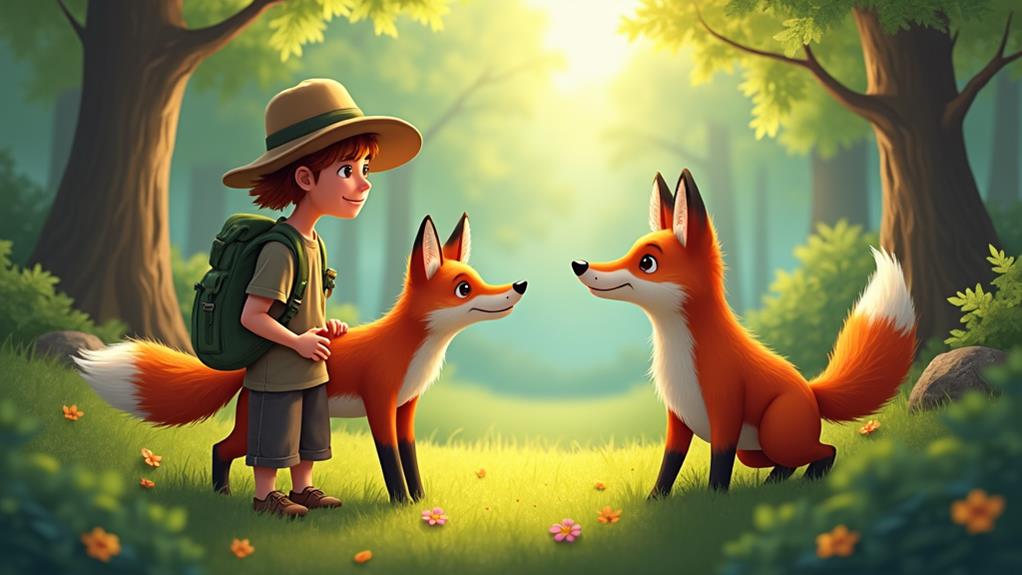
Engaging with red foxes can be a rewarding experience if you follow some best practices. First and foremost, always prioritize observation from a distance. These wild animals are naturally curious, but approaching too closely can make them uncomfortable or cause them to rely on humans for food.
Speaking of food, if you decide to share a snack, do so responsibly. Avoid processed items and scatter food to prevent any territorial squabbles among foxes.
You'll also want to maintain a clean environment. By securing trash and animal enclosures, you help keep foxes foraging naturally instead of depending on human food sources. Understanding fox behavior—like their playful antics—can deepen your appreciation for them while quelling fears about their danger.
Lastly, educating others about the ecological role of red foxes fosters positive interactions. Remember, they play a significant part in keeping local wildlife balanced.
Playfulness and Social Dynamics
Beneath their sleek fur and cunning demeanor, red foxes come alive through playfulness and social interactions. These creatures bring joy and excitement to their environment, and understanding their playful side offers a glimpse into their social dynamics.
Here are three fascinating aspects to reflect on:
- Strengthens Family Bonds: Foxes engage in social play with their cubs and peers, helping to build strong connections within family groups.
- Courtship Fun: Adult foxes exhibit playful behavior during courtship rituals, showing that play is essential in mate selection and bonding.
- Curiosity Adventure: Their thrill-seeking antics reveal emotional depth and a strong need for social interaction, even with larger animals.
When you spot a red fox playing, you're witnessing more than just whimsy. These interactions, especially in urban areas, create a sense of familiarity and comfort with humans.
It's a reminder that nature offers us the chance to connect, encouraging you to appreciate these charismatic animals even more.
Long-Term Coexistence Strategies
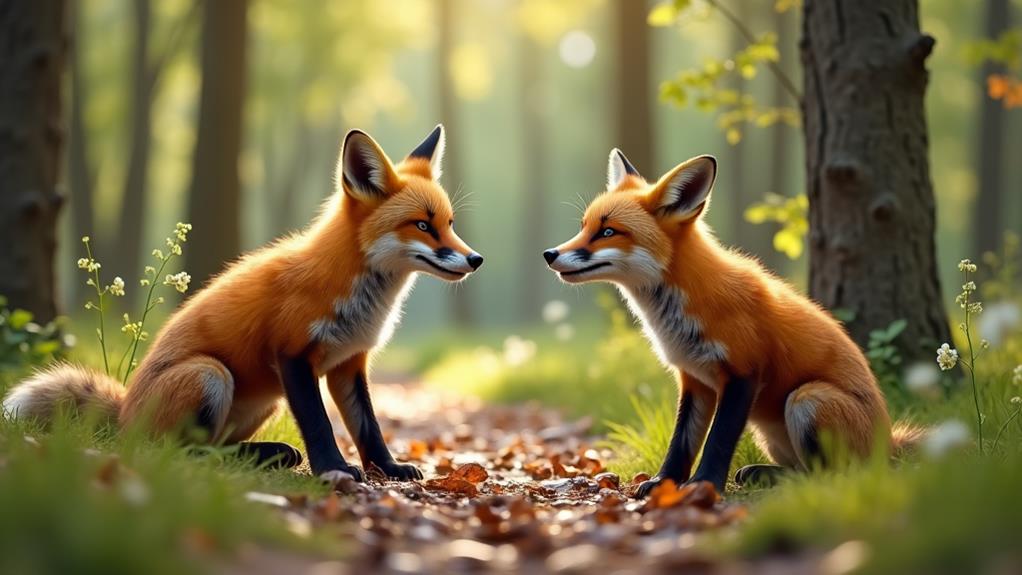
Creating a harmonious relationship between humans and red foxes requires thoughtful strategies that prioritize coexistence. One way to do this is by establishing feeding stations with appropriate food and water. This can promote positive interactions while preventing fox dependency on human sources. By scattering food instead of placing it all in one spot, you can reduce territorial disputes among visiting foxes—just think of it as a buffet where everyone gets their fair share!
Education plays an essential role, too. Teaching folks about responsible wildlife engagement, like avoiding hand-feeding and respecting foxes' natural behaviors, can help minimize conflicts and support healthy fox populations. You want to encourage foxes to remain wild while enjoying their presence.
If you find foxes hanging out too close for comfort, consider implementing noise deterrents, like loud sounds. This can gently send them back to their natural haunts. Remember, observation from a distance is key! It allows you to appreciate these clever creatures without compromising their wild nature.
Final Thoughts
In the end, understanding red foxes really comes down to the dance between nature and nurture. Just like people, they can be friendly or standoffish based on their surroundings and experiences. By respecting their space and learning to coexist, we can appreciate these clever creatures without turning them into the neighborhood troublemakers. So, let's tiptoe around their world like a gentle breeze, fostering a friendship that's as wild and beautiful as the laughter of nature itself.














